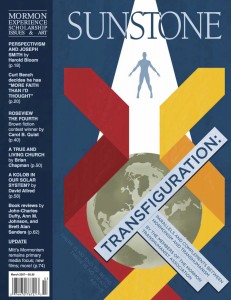 This is the second in a series of posts on Mormon Tranhumanism. The first was written by James Carroll.
This is the second in a series of posts on Mormon Tranhumanism. The first was written by James Carroll.
Many people are surprised to discover that Mormonism and Transhumanism have anything in common. In fact, they are remarkably compatible. In this post I’ve collected a number of Mormon teachings that have fascinating parallels in transhumanism. If you find these interesting, please feel free to dive further by reading our seminal article on Mormon transhumanism in Sunstone magazine.
1. Our divine destiny as children of God.
Joseph Smith taught in his final general conference address (often referred to as the “King Follett” discourse) that God is a being like us, and that he achieved his exalted state by a gradual process of eternal progression. Joseph taught that we must “learn how to be Gods [our]selves.” One of our most well-known primary songs teaches children that they are “a child of God” with unlimited potential, whose destiny is to become like their heavenly parents. Joseph Smith’s vision of the three degrees of glory revealed that the heirs of the celestial kingdom will be “made equal” to God (D&C 76).
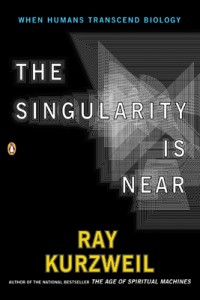 Transhumanists see humanity as being in a state of accelerating progress. While some hesitate to talk about this progress in religious terms, others embrace the more far-flung implications openly. Ray Kurzweil, author and inventor who popularized many transhumanist concepts with his bestselling novel The Singularity Is Near,
Transhumanists see humanity as being in a state of accelerating progress. While some hesitate to talk about this progress in religious terms, others embrace the more far-flung implications openly. Ray Kurzweil, author and inventor who popularized many transhumanist concepts with his bestselling novel The Singularity Is Near,
describes human progress as a spiritual journey:
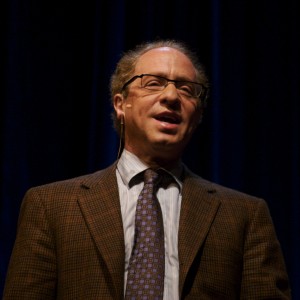
Ray Kurzweil, a prominent transhumanist, believes that human progression is “essentially a spiritual undertaking.” (Image credit)
Evolution moves toward greater complexity, greater elegance, greater knowledge, greater intelligence, greater beauty, greater creativity, and greater levels of subtle attributes such as love. In every monotheistic tradition God is likewise described as all of these qualities, only without any limitation: infinite knowledge, infinite intelligence, infinite beauty, infinite creativity, infinite love, and so on. Of course, even the accelerating growth of evolution never achieves an infinite level, but as it explodes exponentially it certainly moves rapidly in that direction. So evolution moves inexorably toward this conception of God, although never quite reaching this ideal. We can regard, therefore, the freeing of our thinking from the severe limitations of its biological form to be an essentially spiritual undertaking. (The Singularity Is Near, 284)
2. God’s work is “to bring to pass the immortality and eternal life of [humanity.]”
Mormonism teaches that embodiment is essential to eternal progression and that everyone who has lived will eventually receive an immortal body and have the opportunity to live the type of life God does, which is referred to as “eternal life” (Moses 1:39). Mormons believe that it is their duty to assist God in this work.
Transhumanists believe that science and technology will eventually enable us to repair the damage done by the aging process and live indefinitely.
Other scientists are hard at work on the task of understanding the functioning of the human brain to the point where they can eventually backup (and restore) an individual’s memories and brain makeup, opening the possibility of resurrecting someone who gets “backed up” before experiencing an untimely death.
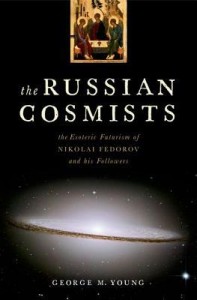 Some transhumanists speculate further that it may someday be possible to retrieve sufficient information about our ancestors that we could reconstruct their bodies and memories and eventually resurrect the human race. Nikolai Fyodorovich Fyodorov was a Russian Orthodox Christian philosopher and forerunner of the transhumanist movement who believed it was humanity’s duty to use science and technology to resurrect the dead.
Some transhumanists speculate further that it may someday be possible to retrieve sufficient information about our ancestors that we could reconstruct their bodies and memories and eventually resurrect the human race. Nikolai Fyodorovich Fyodorov was a Russian Orthodox Christian philosopher and forerunner of the transhumanist movement who believed it was humanity’s duty to use science and technology to resurrect the dead.
Mormon transhumanists see these and other trends as the fulfillment of prophecy and a collaborative effort with God.
3. Surprising developments in the latter days.
Mormons believe that we live in a special time during the history of the earth known as the “dispensation of the fulness of times,” a time in which lost truths will be restored and new truths will be revealed. It will be a time of rapid change that will take many by surprise, “as a thief in the night” (1 Thes. 5:2). Mormons believe that this period will culminate in the return of Jesus Christ, who will usher in a period of prosperity and peace on the earth.
One of the most notable contributions of transhumanism is Ray Kurzweil’s “Law of Accelerating Returns,” which points out that technological progress follows a rather unintuitive exponential curve rather than the more familiar linear rate of progress.
Many different industries are currently experiencing exponential progress. Computers are doubling in processing capacity roughly every year-and-a-half. The average smartphone today is millions of times more powerful and less expensive than the computer that took humans to the moon, and they are everywhere. Near-term projections are that computers will be embedded into nearly all surfaces and devices around us, as well within our bodies, communicating wirelessly with each other to provide detailed locational awareness and remote sensing capabilities.
At the present rate of progress in computing capacity, which has been sustained for over a century and which many scientists expect to continue for at least a few more decades, the average computer will in ten years have roughly the computational capacity of the human brain. This does not mean that computers will be able to think like a human but they will have the necessary hardware for doing so.
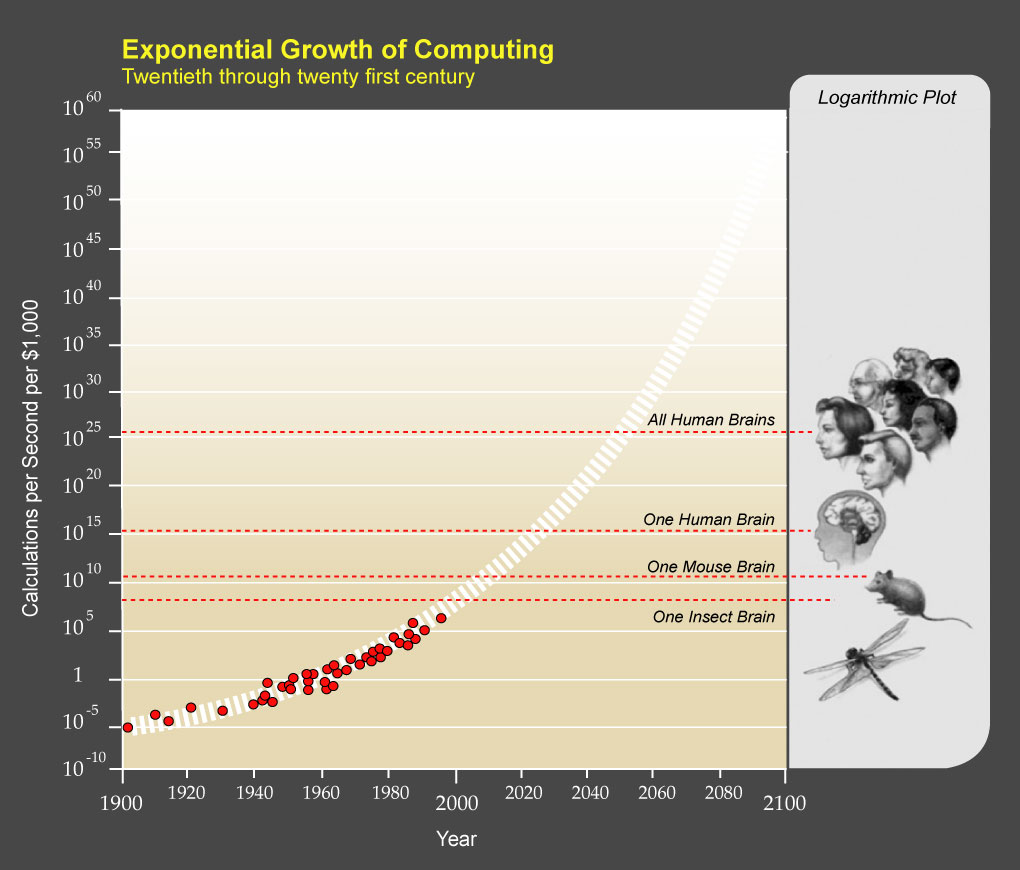 While remarkable, this progress doesn’t really astound until you extrapolate a few more decades into the future. If, as Kurzweil and others predict, technological advances enable the growth in computing capacity to continue at its present pace, by 2045, the average computer is expected to have roughly the capacity of all the human brains in the entire world combined! And these computers are expected to be ubiquitous, embedded in our surroundings, our clothing and even our bodies. Even if general artificial intelligence is not achieved by this time, such computers would be capable of solving many currently intractable problems in biology, medicine, physics and other fields, that would enable numerous other amazing advances, including the elimination of aging and disease.
While remarkable, this progress doesn’t really astound until you extrapolate a few more decades into the future. If, as Kurzweil and others predict, technological advances enable the growth in computing capacity to continue at its present pace, by 2045, the average computer is expected to have roughly the capacity of all the human brains in the entire world combined! And these computers are expected to be ubiquitous, embedded in our surroundings, our clothing and even our bodies. Even if general artificial intelligence is not achieved by this time, such computers would be capable of solving many currently intractable problems in biology, medicine, physics and other fields, that would enable numerous other amazing advances, including the elimination of aging and disease.
Many Mormon transhumanists believe that these accelerating and surprising changes can be seen as tokens of the dispensation of the fulness of times. Some see the increasingly just and beautiful civilization emerging from these advances as a manifestation of the body of Christ (the human ideal) returning in glory.
4. A naturalistic view of spiritual manifestations and miracles.
Mormon theology has placed special emphasis on God’s adherence to logic and natural law, and the need to provide a rational explanation for divine operations. Departing from the Calvinist doctrine of God’s absolute supremacy as the creator of all matter, Joseph Smith taught instead that God was a discoverer who subsequently worked to shape the world according to his will:
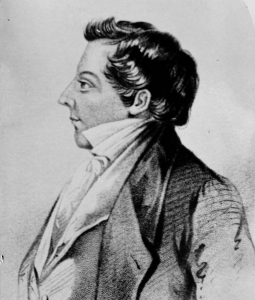 God himself, finding he was in the midst of spirits and glory, because he was more intelligent, saw proper to institute laws whereby the rest could have a privilege to advance like himself. The relationship we have with God places us in a situation to advance in knowledge. He has power to institute laws to instruct the weaker intelligences, that they may be exalted with himself.
God himself, finding he was in the midst of spirits and glory, because he was more intelligent, saw proper to institute laws whereby the rest could have a privilege to advance like himself. The relationship we have with God places us in a situation to advance in knowledge. He has power to institute laws to instruct the weaker intelligences, that they may be exalted with himself.
Now, the word create . . . does not mean to create out of nothing; it means to organize; the same as a man would organize materials and build a ship. Hence, we infer that God had materials to organize the world out of chaos—chaotic matter, which is element. . .
Element had an existence from the time [God] had. The pure principles of element are principles which can never be destroyed; they may be organized and reorganized, but not destroyed. They had no beginning and can have no end. (King Follett Discourse)
Not only is matter eternal, but all spiritual phenomena have materialistic explanations, despite our present lack of understanding. “There is no such thing as immaterial matter. All spirit is matter, but it is more fine or pure, and can only be discerned by purer eyes” (D&C 131:7). Miracles are understood as presently irreproducible events that defy explanation but necessarily adhere to law, and over which we will someday have control:
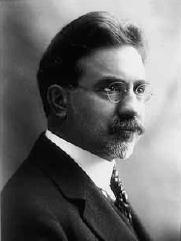 A miracle is an occurrence which, first, cannot be repeated at will by man, or, second, is not understood in its cause and effect relationship. History is filled with such miracles. What is more, the whole story of man’s progress is the conversion of “miracles” into controlled and understood events. The airplane and radio would have been miracles, yesterday. (John A. Widtsoe, Evidences and Reconciliations, 129)
A miracle is an occurrence which, first, cannot be repeated at will by man, or, second, is not understood in its cause and effect relationship. History is filled with such miracles. What is more, the whole story of man’s progress is the conversion of “miracles” into controlled and understood events. The airplane and radio would have been miracles, yesterday. (John A. Widtsoe, Evidences and Reconciliations, 129)
Mormons tend to embrace scientific discovery and advancement, believing that “the glory of God is intelligence” (D&C 93:36) and that “a man is saved no faster than he gets knowledge.”
This emphasis on emulating God as we strive to understand and control the natural world has strong parallels with the Transhumanist view of continually progressing humans who seek increasing understanding of and control over their anatomies and environments.
5. The importance of our own efforts in building Zion.
Mormonism teaches that we “should be anxiously engaged in a good cause, and do many things of [our] own free will, and bring to pass much righteousness;” (D&C 58:27) We learn in the Book of Mormon that God won’t save us if we don’t use the means that he has provided (Alma 60:21). Mormon transhumanists believe that “science and technology are among the means ordained of God” for bringing to pass the futures we hope for. (Mormon Transhumanist Affirmation)
Latter-day prophets have also affirmed the necessity of our own participation in the redemptive work of the latter days:
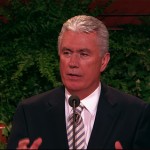 “When our wagon gets stuck in the mud, God is much more likely to assist the man who gets out to push than the man who merely raises his voice in prayer — no matter how eloquent the oration.” (Dieter F. Uchtdorf, Oct 2009 General Conference)
“When our wagon gets stuck in the mud, God is much more likely to assist the man who gets out to push than the man who merely raises his voice in prayer — no matter how eloquent the oration.” (Dieter F. Uchtdorf, Oct 2009 General Conference)
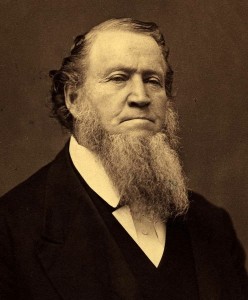 You may now be inclined to say, “O, this is too simple and child-like, we wish to hear the mysteries of the kingdoms of the Gods who have existed from eternity and of all the kingdoms in which they will dwell; we desire to have these things portrayed to our understandings.” Allow me to inform you that you are in the midst of it all now, that you are in just as good a kingdom as you will ever attain to, from now to all eternity, unless you make it yourselves by the grace of God, by the will of God, by the eternal Priesthood of God, which is a code of laws perfectly calculated to govern and control eternal matter. If you and I do not by this means make that better kingdom which we anticipate, we shall never enjoy it. We can only enjoy the kingdom we have labored to make. (Brigham Young, Journal of Discourses 3: 336)
You may now be inclined to say, “O, this is too simple and child-like, we wish to hear the mysteries of the kingdoms of the Gods who have existed from eternity and of all the kingdoms in which they will dwell; we desire to have these things portrayed to our understandings.” Allow me to inform you that you are in the midst of it all now, that you are in just as good a kingdom as you will ever attain to, from now to all eternity, unless you make it yourselves by the grace of God, by the will of God, by the eternal Priesthood of God, which is a code of laws perfectly calculated to govern and control eternal matter. If you and I do not by this means make that better kingdom which we anticipate, we shall never enjoy it. We can only enjoy the kingdom we have labored to make. (Brigham Young, Journal of Discourses 3: 336)
Although some Mormons claim that the world is steadily increasing in wickedness, Mormon transhumanists tend to be more optimistic. They believe that the world is in fact demonstrably better than it has ever been before. They also recognize that any forced divine intervention cannot lead to exaltation, and instead embrace positive visions of a future in which we join with Christ to create the better world we hope for. Achieving such a better world will not happen unless we first believe in its possibility. Our recent prophet, Gordon B. Hinckley, shared this optimism:
 But in a larger sense this has been the best of all centuries. In the long history of the earth there has been nothing like it. The life expectancy of man has been extended by more than 25 years. Think of it. It is a miracle. The fruits of science have been manifest everywhere. By and large, we live longer, we live better. This is an age of greater understanding and knowledge. We live in a world of great diversity. As we learn more of one another, our appreciation grows. This has been an age of enlightenment. The miracles of modern medicine, of travel, of communication are almost beyond belief. All of this has opened new opportunities for us which we must grasp and use for the advancement of the Lord’s work. (Gordon B. Hinckley, General Conference address, April 1999)
But in a larger sense this has been the best of all centuries. In the long history of the earth there has been nothing like it. The life expectancy of man has been extended by more than 25 years. Think of it. It is a miracle. The fruits of science have been manifest everywhere. By and large, we live longer, we live better. This is an age of greater understanding and knowledge. We live in a world of great diversity. As we learn more of one another, our appreciation grows. This has been an age of enlightenment. The miracles of modern medicine, of travel, of communication are almost beyond belief. All of this has opened new opportunities for us which we must grasp and use for the advancement of the Lord’s work. (Gordon B. Hinckley, General Conference address, April 1999)
In my next post I will share a transhumanist interpretation of the Gospel of Christ.





I was going to totally send this to you Carl. Until I saw you wrote it 🙂
Great post! Admittedly, I’m uncomfortable with the deep societal changes that would accompany transhumanism if half of these changes were realized, but I like the idea that Mormonism is flexible enough to handle these changes. I think that a lot of traditional, Biblical Christianity would struggle with reconciling itself to transhumanism, and even if Mormons aren’t any better, Mormonism itself could. And I think you’ve done a great job showing how that could work.
Thanks David, I’m glad these thoughts proved useful.
Fascinating. I know so little about transhumanism, and now I can tell people some similarities between it and Mormonism. Thank you.
Carl,
Mormon cosmology, as it is commonly interpreted, sees an infinite-past of Gods. This, usually, is seen as negating the “big bang” theory because it negates the doctrine of creation ex nihilo. However, there are logical problems with an infinite-past. Does transhumanism have any particular view on this?
mike
Mike,
Are the logical problems ones of logical inconsistencies with the idea itself, or with inconsistencies with certain assumptions some people make about the nature of existence? Or are they not logical problems at all, but problems of imagination or taste?
Infinite past Gods are a problem if we assume God’s existence (and Gods’ existences) are limited to the observable universe, but are no problem at all if we accept certain possible multiverses and that some portion of God’s being exists outside of our observable universe. We have to hope one of these possible scenarios is real if we hope to live forever ourselves.
Of course, transhumanism doesn’t have one view on the eternity of gods, or even our own longevity, it has many. Mormon Transhumanism I think favors speculation of Gods’ and our beings extending beyond the observable universe in some unknown way. One way would be passing into black holes (i.e. God calculates himself into a new universe made in a black hole, and repeats ad infinitem). I’m not a fan of this alternative for esthetic reasons, but it is one example.
Jonathan
Michael, transhumanists generally are not afraid of wild speculation and enjoy science fiction, so it’s not uncommon to hear them share various theories about the origins of the universe.
I’m not sure to what extent you are aware of brane-theory and other cosmological esoterica, but my layman’s understanding is that many leading cosmologists don’t think of the big bang as the beginning of everything that ever was, but merely as a singularity that may have kicked off this particular universe. According to this theory, each universe is essentially a single slice in a larger “loaf,” and big bangs may be collisions between slices. Some cosmologists theorize that it may be possible to transfer information between slices.
There are also theories that black holes give rise to new universes. Some have even speculated that universes themselves may undergo a process of natural selection through which some become more and more suited to some kind of cosmological equivalent of species flourishing.
These are just the beginning of all sorts of interesting speculation that in my mind could easily be compatible with the concept of an infinite or at least indefinite regression of gods.
There are of course other theories such as the simulation argument, which open up the possibility for the universe we are currently in to be only one of many different computational substrates upon which the software of ‘existence’ is run.
Nice summary, Carl. I think I’ll borrow it for some talking points.
Interesting that whenever male theologians (such as Joseph Smith) look back in time all they report seeing is one or more male Gods. Seems as if they look back with one eye shut as they fail to see (or properly acknowledge and honor) the equally important feminine face of the Divine.